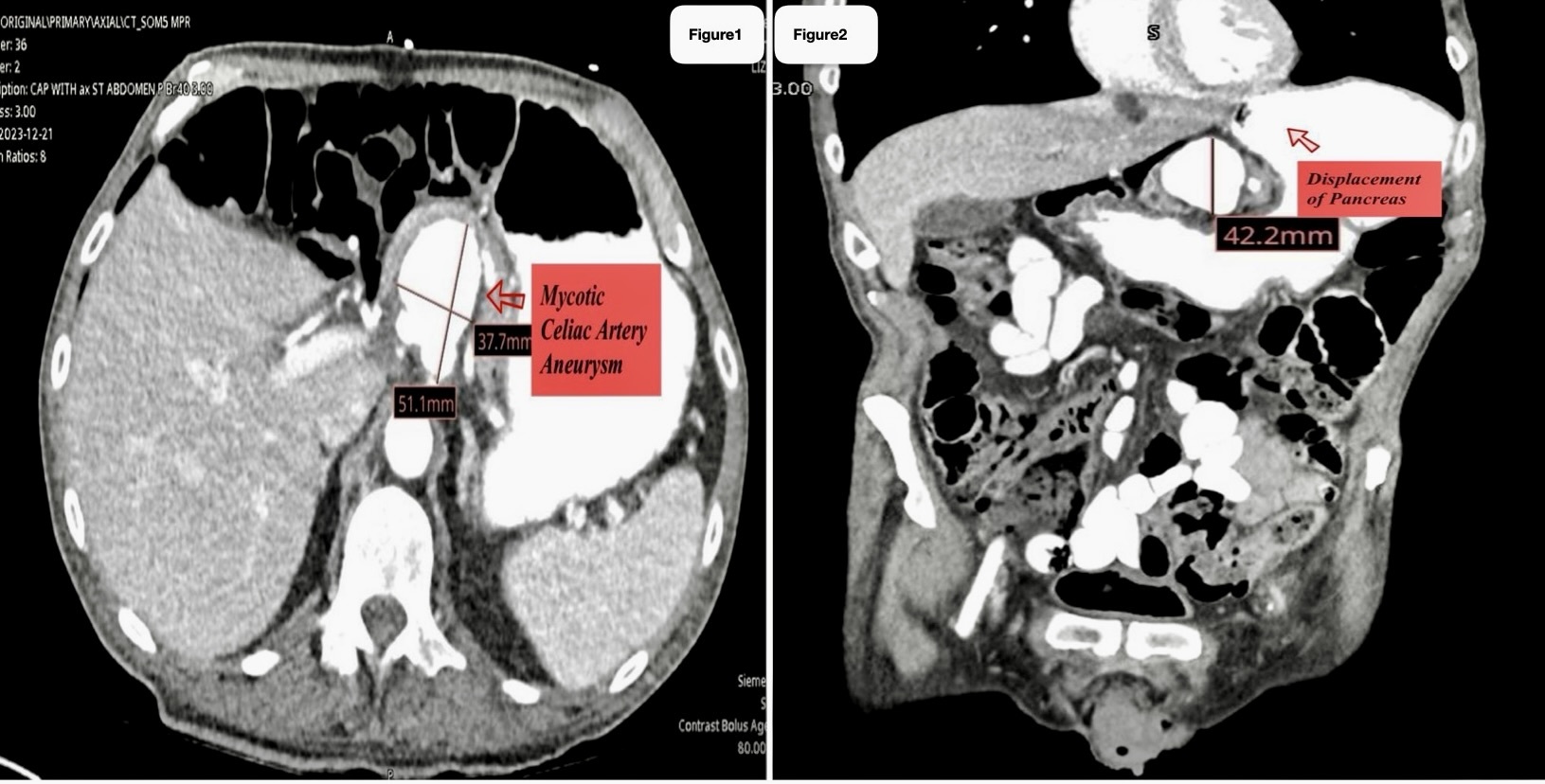Tuesday Poster Session
Category: Stomach
P5130 - A Rare Case Report: The Silent Lethality of Mycotic Celiac Artery Aneurysm
Tuesday, October 29, 2024
10:30 AM - 4:00 PM ET
Location: Exhibit Hall E

Has Audio

Jacob Theriault, DO
Lake Erie College of Osteopathic Medicine
Bradenton, FL
Presenting Author(s)
Gautam Maddineni, MD1, Jacob Theriault, DO2, Angela Barnes, MD, MBChB3, Navkiran Randhawa, DO3, Kelsey Theriault, DO1, Iasmina Jivanov, MD1
1Florida State University, Cape Coral, FL; 2Lake Erie College of Osteopathic Medicine, Bradenton, FL; 3Medical College of Georgia at Augusta University, Augusta, GA
Introduction: Celiac artery aneurysms are extremely rare, accounting for only 0.01% of cases. Mycotic celiac artery aneurysms are even rarer, with only 6 reported cases to date. Mycotic aneurysms result from an arterial wall infection secondary to bacteremia. The symptoms resemble those of celiac artery aneurysms, including early satiety, weight loss, nausea, and abdominal pain. However, they have a significantly high mortality rate due to rapid growth and the imminent risk of rupture caused by the endarterial infection.
Case Description/Methods: A 74-year-old male with a 60-pack-year smoking history, aortic stenosis status post aortic valve replacement, and a history of early satiety, abdominal pain, and weight loss over the past 6 months was admitted to the hospital with fever, chills, dysuria, and pneumaturia. Initial lab results indicated leukocytosis and blood cultures confirmed enterococcus bacteremia. The patient's chronic untreated Colo-Vesical fistula was likely the presumed source. Due to persistent bacteremia, the patient underwent a CT scan with contrast, which revealed a large celiac artery aneurysm measuring 5.1 x 3.8 x 4.2 cm with lobulated contours, suspected to be a mycotic aneurysm. Despite recommendations for a transesophageal echocardiogram and vascular surgery intervention, the patient opted for conservative management. He was treated for bacteremia with IV ampicillin and ceftriaxone. He was discharged on lifelong suppressive therapy of amoxicillin-clavulanic acid in the setting of an untreated mycotic celiac artery aneurysm. Unfortunately, he succumbed to an aneurysm rupture a few months later.
Discussion: Mycotic celiac artery aneurysms are exceedingly uncommon and typically result from arterial wall infections caused by bacteremia. Symptoms are nonspecific and may include early satiety, weight loss, abdominal pain, and signs of systemic infection. The diagnosis heavily relies on CT or MRI imaging to reveal the characteristics and extent of the aneurysm. Treatment involves a combination of antimicrobial therapy and surgical intervention, although surgery may not be an option for some patients, as illustrated in this case. Without intervention, the prognosis is poor due to the high risk of rupture and mortality. Therefore, early diagnosis, comprehensive management, and patient education are crucial to improve outcomes. This case highlights the importance of vigilance in diagnosing and managing this rare but life-threatening condition.

Disclosures:
Gautam Maddineni, MD1, Jacob Theriault, DO2, Angela Barnes, MD, MBChB3, Navkiran Randhawa, DO3, Kelsey Theriault, DO1, Iasmina Jivanov, MD1. P5130 - A Rare Case Report: The Silent Lethality of Mycotic Celiac Artery Aneurysm, ACG 2024 Annual Scientific Meeting Abstracts. Philadelphia, PA: American College of Gastroenterology.
1Florida State University, Cape Coral, FL; 2Lake Erie College of Osteopathic Medicine, Bradenton, FL; 3Medical College of Georgia at Augusta University, Augusta, GA
Introduction: Celiac artery aneurysms are extremely rare, accounting for only 0.01% of cases. Mycotic celiac artery aneurysms are even rarer, with only 6 reported cases to date. Mycotic aneurysms result from an arterial wall infection secondary to bacteremia. The symptoms resemble those of celiac artery aneurysms, including early satiety, weight loss, nausea, and abdominal pain. However, they have a significantly high mortality rate due to rapid growth and the imminent risk of rupture caused by the endarterial infection.
Case Description/Methods: A 74-year-old male with a 60-pack-year smoking history, aortic stenosis status post aortic valve replacement, and a history of early satiety, abdominal pain, and weight loss over the past 6 months was admitted to the hospital with fever, chills, dysuria, and pneumaturia. Initial lab results indicated leukocytosis and blood cultures confirmed enterococcus bacteremia. The patient's chronic untreated Colo-Vesical fistula was likely the presumed source. Due to persistent bacteremia, the patient underwent a CT scan with contrast, which revealed a large celiac artery aneurysm measuring 5.1 x 3.8 x 4.2 cm with lobulated contours, suspected to be a mycotic aneurysm. Despite recommendations for a transesophageal echocardiogram and vascular surgery intervention, the patient opted for conservative management. He was treated for bacteremia with IV ampicillin and ceftriaxone. He was discharged on lifelong suppressive therapy of amoxicillin-clavulanic acid in the setting of an untreated mycotic celiac artery aneurysm. Unfortunately, he succumbed to an aneurysm rupture a few months later.
Discussion: Mycotic celiac artery aneurysms are exceedingly uncommon and typically result from arterial wall infections caused by bacteremia. Symptoms are nonspecific and may include early satiety, weight loss, abdominal pain, and signs of systemic infection. The diagnosis heavily relies on CT or MRI imaging to reveal the characteristics and extent of the aneurysm. Treatment involves a combination of antimicrobial therapy and surgical intervention, although surgery may not be an option for some patients, as illustrated in this case. Without intervention, the prognosis is poor due to the high risk of rupture and mortality. Therefore, early diagnosis, comprehensive management, and patient education are crucial to improve outcomes. This case highlights the importance of vigilance in diagnosing and managing this rare but life-threatening condition.

Figure: Image: CT Abdomen with Contrast
Figure 1: Mycotic celiac artery aneurysm
Figure 2: Pancreatic body displaced
Figure 1: Mycotic celiac artery aneurysm
Figure 2: Pancreatic body displaced
Disclosures:
Gautam Maddineni indicated no relevant financial relationships.
Jacob Theriault indicated no relevant financial relationships.
Angela Barnes indicated no relevant financial relationships.
Navkiran Randhawa indicated no relevant financial relationships.
Kelsey Theriault indicated no relevant financial relationships.
Iasmina Jivanov indicated no relevant financial relationships.
Gautam Maddineni, MD1, Jacob Theriault, DO2, Angela Barnes, MD, MBChB3, Navkiran Randhawa, DO3, Kelsey Theriault, DO1, Iasmina Jivanov, MD1. P5130 - A Rare Case Report: The Silent Lethality of Mycotic Celiac Artery Aneurysm, ACG 2024 Annual Scientific Meeting Abstracts. Philadelphia, PA: American College of Gastroenterology.
